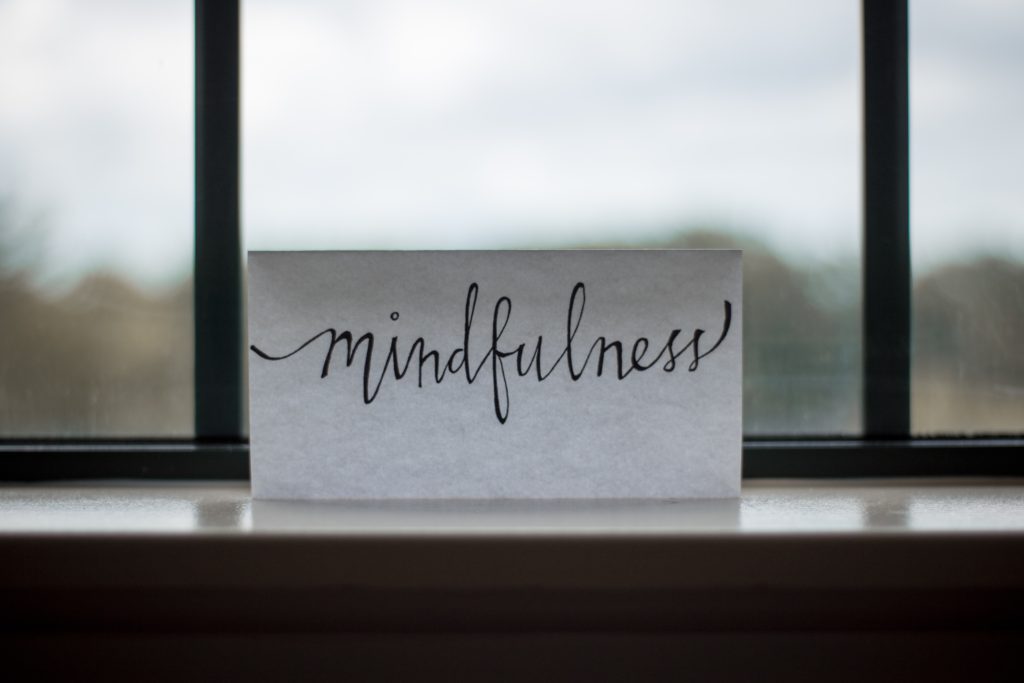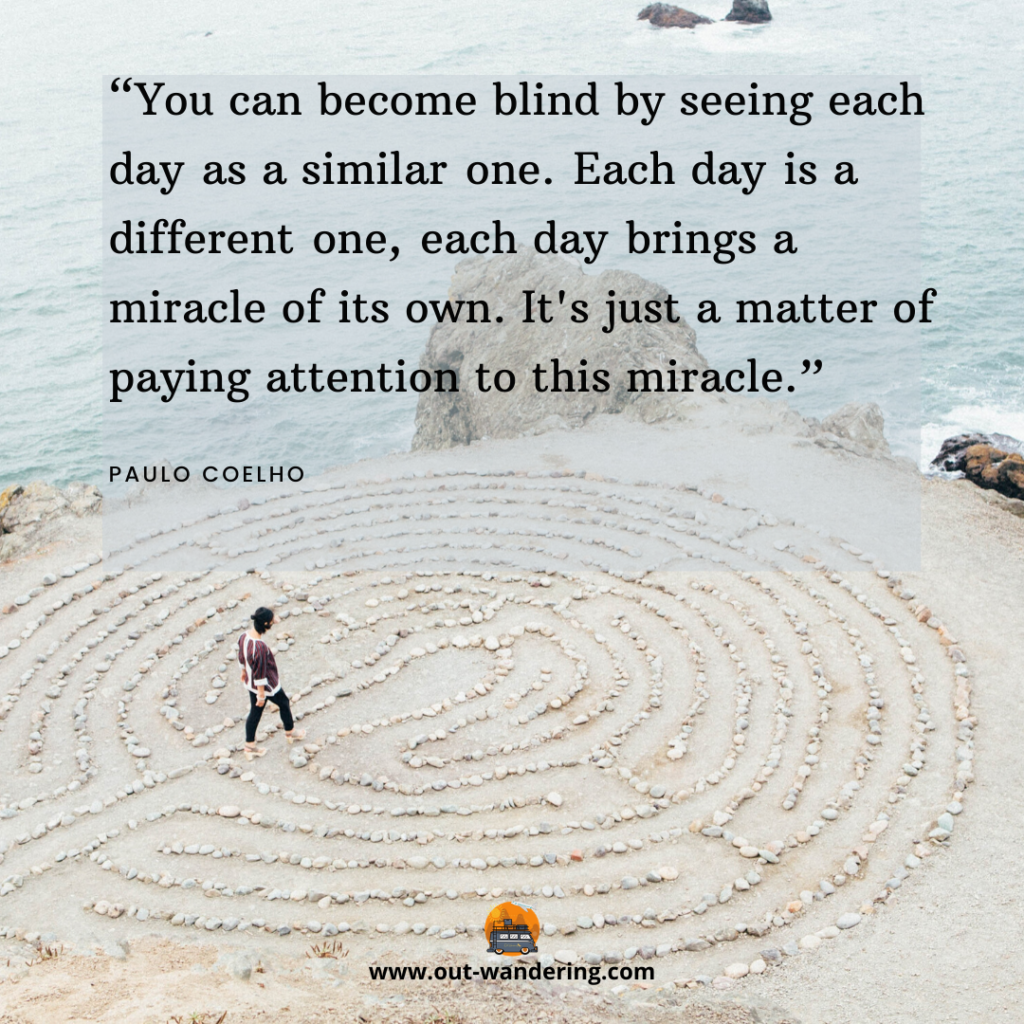The Monkey Business Illusion by Daniel Simons
On average, we have 60,000 thoughts per day or about 48 thoughts per minute. 80% are negative ones, and 95% of those thoughts are the same we had yesterday, last week, last year or even ten years ago, meaning your mind is on autopilot almost 100% of the time. The habit-groove is a deep one and overcoming mindless habit sound overwhelming, but there is hope!
How observant were you? Count how many times did the players in white pass the ball? Did you see the color of the backdrop change? Did you see the gorilla? How many times did you find your mind wandering off of the video to another thought?
Mindfulness is a mental state achieved by focusing your awareness on the present moment while calmly acknowledging and accepting your feelings, thoughts, and body sensations.


Being mindful is so good for us
By improving the ability to focus, mindfulness regulates intense feelings and will even help us relax. It may lower our blood pressure, reduce GI troubles and increase the function of your immune system. Mindfulness can help us tolerate pain and help diminish many disease symptoms as well as everyday aches and pains.
Mindfulness is being aware and awake rather than operating unconsciously or on autopilot. Our brains are trained to agonize and worry about everything, and although a mindfulness practice isn’t always easy, it is a skill we can cultivate through daily practice. The key is to carve out time and do it regularly.
Catch auto-pilot as soon as possible
Being consciously present, we are aware of two aspects of each moment-to-moment experience: what’s going on around us and what’s going on inside of us. Being mindful means to be consciously present in what you’re doing while you’re doing it, managing your mental and emotional state.
Our mind is away more than it is present. A first step in cultivating greater mindfulness is first to notice that your mind has wandered off. The sooner we become aware this has happened, the more effective we become in our mindfulness practice.


Four easy ways to start being more mindful
- Practice right when you wake up. Before you even get out of bed, do a full body scan and breathe life into each cell of your body. Then set an intention, making a clear decision that you will be as present as you can in the day ahead.
- Practice mindfulness during routine activities. Try bringing awareness to the daily activities you usually do on autopilot like brushing your teeth. Feel the brush on each tooth. Smell the minty freshness as you make the brushing motions. Maybe even use the opposite hand to brush your hair in the morning.
- Pick a prompt to remind you to be mindful. When noticing our mind is wandering off again, have a quick prompt ready to bring you back. It could be something as easy as sitting up straighter or blinking our eyes a few times.
- Set an intention for your day and make a clear decision and start your day off in the best possible way by being as present. Researchers have found that we release the most stress hormones within minutes after waking. Why? Because thinking of the day ahead triggers our fight-or-flight instinct and releases cortisol into our blood. Instead, try this: When you wake up, spend two minutes in your bed, simply noticing your breath. As thoughts about the day pop into your mind, let them go and return to your breath.
What is cortisol? Cortisol is a steroid hormone that is produced by the adrenal glands which sit on top of each kidney. When released into the bloodstream, cortisol can act on many different parts of the body and can help your body respond to stress or danger; it increases your body's metabolism of glucose, it controls your blood pressure and reduces inflammation.

Mindfulness Exercise
1- Follow your breath for two minutes. You can use the breath ball/fingers inhaling as the ball expands, exhaling when the ball contracts.
2 -Notice when your mind has strayed. Inevitably, our attention will leave the breath and wander to other places. As we get around to noticing that our focus has wandered—in a few seconds, a minute, five minutes—simply return your attention to the breath.
3 – Be kind to your wandering mind. Don’t judge yourself or obsess over the content of the thoughts you find yourself lost in – just come back.
4 – Close with some kindness. When you’re ready, gently lift the gaze and take a moment and notice any sounds in the environment. Notice how your body feels right now. Notice your thoughts and emotions and give yourself a big mental hug of gratitude.seconds, a minute, five minutes—simply return your attention to the breath.


Mindfulness is a simple practice
As focus is the ability to concentrate on what we’re doing in the moment, awareness is the ability to recognize and release unnecessary distractions as they arise. Becoming aware is a discipline that needs to be repeated – creating a new groove of intention and doing. Quiet enough of those 60,000 thoughts and we increase effectiveness, decrease mistakes and enhance.

Share this post

|
I am an influencer of optimism, positivity & love. By acting on my dreams, I hope to inspire others to do the same. Being where my feet are means that we live in the moment with curiosity, creativity, courage & compassion. Live your happiest, best life. You’ll find resources and stories mostly on subjects like travel, van living, exploring, yoga, and photography on this site. It’s my hope you will be inspired to do something you’ve always wanted to do too. Say YES, take that first step. |
Follow along! Kirsti’s vision is to enjoy life with passion and curiosity. Kirsti Out Wandering aspires to exemplify well-being in mind, body & spirit, giving unconditional love to self and others, and pursuing all of the wild possibilities life serves up while living full-time from a sprinter van. She offers a monthly roundup that includes stories and tips on travel & exploring, van living, self-care, photography and service.

